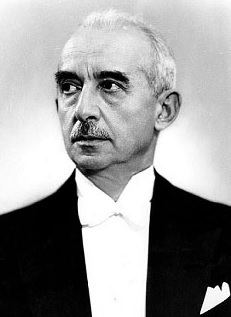 | ||
The Adana Conference or Yenice Conference (Turkish: Adana Görüşmesi , Adana Mülakatı or Yenice Görüşmesi , Yenice Mülakatı ) was a meeting between Turkish President İsmet İnönü and British Prime Minister Winston Churchill in a railroad car parking on a storage track at Yenice near Adana on 30–31 January 1943, where Churchill tried to persuade İnönü to join the Allied Forces and fight the Axis powers during World War II.
Contents
Location
The event came to be known as the Adana Meeting later. But in fact, the meeting was held, not in Adana, but in a railroad car on a storage track at the Yenice Railway Station, It is the main railroad junction of the Adana–Mersin Railway Line and the main railroad from the north (i.e. İstanbul-Bağdat Railway). Yenice is a town of Tarsus district in Mersin Province, Turkey. The choice of this location was decided after a series of talks between the Turkish Foreign Ministry and the British embassy in Ankara. The earlier choice of the British side was Cyprus (then a part of British Empire) and the choice of Turkish side was Ankara.
Background
During World War II, all the neighbours of Turkey were either a part of the Axis powers or the Allies. In the west, Bulgaria was an ally of Nazi Germany and Greece was occupied by German troops. Dodecanese, including Rhodes was a part of Italy. While the USSR was a neighbour at the north east, the southern neighbours were Syria, a part of Free France and Iraq, a part of the British Empire, and Iran was under USSR-British joint occupation. Turkey, however, managed to maintain its neutral status.
Aim of the meeting
During the Casablanca Conference ( 14–24 January 1943), Churchill proposed to force Turkey to join the Allies in the war. General Marshall and other high-ranking US military showed extreme reluctance, for fear that the extension of the war to a new Turkish front would "burn the Allied logistics down the line". However, US President Roosevelt gave Churchill the green light on 18 January to 'play the Turkish hand'. On 25 January, Churchill asked for an appointment from İnönü and the Adana Meeting was held just after the conference, between 30 January and 1 February 1943.
Meeting
The teams were headed by İsmet İnönü and Winston Churchill. The other members of the Turkish side were Prime minister Şükrü Saracoğlu, Foreign minister Numan Menemencioğlu, Field marshal Fevzi Çakmak, and a group of advisers. The British team consisted of Harold Alexander, Henry Maitland Wilson, Sir Alan Brooke, Sir Wilfred Lindsell, Alexander Cadogan (foreign ministry), Air Marshal Drummond and Commodore Dundas.
During the meeting, the British tried to persuade Turkish side to join the Allies, but İnönü showed extreme reluctance to join the war. Churchill made lavish promises of military help (code-named operation 'Hardihood'). A list of military equipment was drawn up (the 'Adana Lists'), which – in the words of Churchill – would provide Turkey with war material 'to the full capacity of Turkish railways'. In turn, Churchill requested access to Turkish air bases for the RAF, so the British could bomb the oil fields of Ploieşti in Romania, the principal source of oil for Germany and the Italian positions in Dodecanese. To put pressure on the Turks to give up their neutrality, Churchill made clear that – should Turkey refuse to join the Allies – he would not try to check the Soviets if they made a move to control the Dardanelles.
Aftermath
In April 1943, a British military delegation by General Sir Henry Maitland Wilson requested access of 25 RAF fighter squadrons to Turkish airports. In latter stages of the operation, the British planned on sending two full armoured divisions to Turkey. The Turks however were very fearful of the strong Nazi military presence in Bulgaria, and drowned the British military delegation in red tape. While giving Maitland Wilson every courtesy, the Turks started 'tortuous and interminable negotiations'. Wilson urged Turkish commanders to teach their men mechanical skills, but noted that this meant that prospective tank crews 'had to be taught the workings of the internal combustion engine from page one of the book'. When the construction of Turkish airfields went ahead of schedule, İnönü was warned that work proceeded too rapidly. The British frustration about the Turkish stalling tactics led to a serious deterioration of diplomatic relations between the two countries in the summer of 1943. However, the disastrous British Dodecanese Campaign on 13 September 1943, where the Nazis easily fought off a British assault, ended the strife. The Dodecanese islands are situated at about 20 km (12 mi) south west of the Turkish coast, and the display of Nazi strength convinced the Turkish government that they had rightly pursued a policy of neutrality. And after the fiasco, the British were anxious to see Turkey remain neutral.
Trivia
Although the meeting was held in Yenice, it is sometimes known as the Adana Meeting or Adana Conference . That's because the nearest airport to the Yenice was in Adana a city at the east of Yenice.
